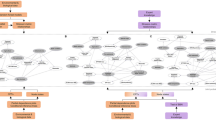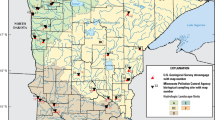Abstract
We propose a formal causal evaluation inference process that uses a local-scale in situ approach and provides statistically defensible correlative conclusions for the biological impairment in 303(d)-listed water bodies. Fish assemblage, water chemistry, and aquatic habitat data from 66 locations in the Limberlost watershed, Indiana, were collected in August 2003 to evaluate the condition of the watershed. Anthropogenic stressors were identified from a numerical classification analysis of fish assemblage data using a biological integrity response gradient. Physical and chemical stressors were evaluated relative to the biological integrity response gradient using the Kruskal Wallis analysis of variance by ranks test. Three water chemistry variables (sodium, chloride, and barium) were associated with biological integrity. The percent run habitat, channel morphology score, and Qualitative Habitat Evaluation Index score varied with the degree of dredging. We observed a negative response between the number of species and the biological integrity gradient and a positive response with the percent tolerant individuals. This local-scale in situ approach to physical and chemical data analysis, combined with concurrent biological data collection, provided correlative relations to the impaired condition with localized environmental stressors.





Similar content being viewed by others
References
Agency for Toxic Substances and Disease Registry (1992) Toxicological profile for barium. United States Department of Health and Human Services, Agency for Toxic Substances and Disease Registry, Atlanta, GA
Becker GC (1983) Fishes of Wisconsin. The University of Wisconsin Press, Madison, WI
Benda L, Poff NL, Miller D, Dunne T, Reeves G, Pess G, et al. (2004) The network dynamics hypothesis: How channel networks structure riverine habitats. Bioscience 54:413–427
Choi J, Engel BA (2003) Watershed delineation: Web-GIS tools for spatial hydrologic analysis. Available at: http://www.pasture.ecn.purdue.edu/∼jychoi/wd_home/. Accessed: 10 Nov 2002
Cormier SM, Norton SB, Suter GW II, Altfater D, Counts B (2002) Determining the causes of impairments in the Little Scioto River, Ohio, USA: Part 2. Characterization of causes. Environ Toxicol Chem 21:1125–1137
Eagleson KW, Lenat DL, Ausley IW, Winterborne EB (1990) Comparison of measured instream biological responses with responses predicted using the Ceriodaphnia dubia chronic toxicity test. Environ Toxicol Chem 9:1091–1028
Etnier DA, Starnes WC (1993) The Fishes of Tennessee. The University of Tennessee Press. Knoxville, TN
Herricks EE, Schaefer JR (1985) Can we optimize biomonitoring? Environ Manage 9:487–492
Indiana Department of Environmental Management (1992) Standard operating procedures for electrofishing. IDEM. Indianapolis, IN
Intergovernmental Task Force on Monitoring Water Quality (1992) Ambient water quality monitoring in the United States: First year review, evaluation, and recommendations. Interagency Advisory Committee on Water Data, United States Environmental Protection Agency, Washington, DC
Intergovernmental Task Force on Monitoring Water Quality (1995) The strategy for improving water quality monitoring in the United States. Final Report of the Intergovernmental Task Force on Monitoring Water Quality. Interagency Advisory Committee on Water Data, United States Environmental Protection Agency, Washington, DC
International Program on Chemical Safety (1990) Barium (Environmental Health Criteria 107). World Health Organization, International Program on Chemical Safety, Geneva, Switzerland
Karr JR, Yoder CO (2004) Biological assessment and criteria improve TMDL planning and decision making. J Environ Engineer 130:594–604
Klein RD (1979) Urbanization and stream quality impairment. Wat Res Bull 15:948–963
Leopold LB, Woolman MG, Miller JP (1964) Fluvial processes in geomorphology. Freeman, San Francisco, CA
Miltner RJ, Rankin ET (1998) Primary nutrients and the biotic integrity of rivers and streams. Freshwat Biol 40:145–158
National Research Council (2001) Assessing the TMDL approach to water quality management. National Academy Press, Washington, DC
Norton SB, Cormier SM, Smith M, Jones C (2000) Can biological assessments discriminate among types of stress? A case study from the Eastern Corn Belt Plains Ecoregion. Environ Toxicol Chem 19:1113–1119
Norton SB, Cormier SM, Suter GW II, Subramanian B, Lin E, Altfater D, et al. (2002) Determining probable causes of ecological impairment in the Little Scioto River, Ohio, USA: Part I. Listing candidate causes and analyzing evidence. Environ Toxicol Chem 21:1112–1124
Ohio Environmental Protection Agency (1989) Biological criteria for the protection of aquatic life. Volume III. Standardized biological field sampling and laboratory methods for assessing fish and macroinvertebrate communities. Ohio Environmental Protection Agency, Division of Water Quality, Monitoring, and Assessment, Columbus, OH
Onorato D, Marion KR, Angus RA (1998) Longitudinal variations in the ichthyofaunal assemblages of the upper Cahaba River: Possible effects of urbanization in a watershed. J Freshwater Ecol 13:139–154
Rankin ET (1989) The qualitative habitat evaluation index (QHEI), rationale, methods, and application. Ohio Environmental Protection Agency, Division of Water Quality Planning and Assessment, Ecological Assessment Section, Columbus, OH
Rankin ET (1995) The use of habitat assessments in water resource management programs. In: Davis WS, Simon TP (eds) Biological assessment and criteria: tools for water resource planning and decision making. CRC, Boca Raton, FL, pp 181–208
Riva-Murray K, Bode RW, Phillips PJ, Wall GL (2002) Impact source determinations with biomonitoring data in New York state: Concondance with environmental data. Northeast Nat 9:127–162
Siegel S, Castellan NJ (1988) Nonparametric statistics for the behavioral sciences, 2nd ed. McGraw-Hill, New York, NY
Simon TP (2003) Biological response signatures: Indicator patterns using aquatic communities. CRC, Boca Raton, FL
Simon TP, Dufour R (1998) Development of index of biotic integrity expectations for the ecoregions of Indiana. V. Eastern Corn Belt plain. EPA 905/R-96/002. United States Environmental Protection Agency, Region V. Water Division. Watershed and Non-Point Source Branch, Chicago, IL
Smith TA, Kraft CE (2005) Stream fish assemblages in relation to landscape position and local habitat variables. Trans Am Fish Soc 134:430–440
StatSoft (2002) STATISTICA for Windows. StatSoft, Tulsa, OK
Suter GW II, Norton SB, Cormier SM (2002) A methodology for inferring the causes of observed impairments in aquatic systems. Environ Toxicol Chem 21:1101–1111
United States Environmental Protection Agency (2000) Stressor identification guidance document. EPA/822/B-00/025. Washington, DC
Wang L, Lyons J, Kanehl P, Bannerman R, Emmons E (2000) Watershed urbanization and changes in fish communities in southeastern Wisconsin streams. J Am Water Res Assoc 36:1173–1189
Yoder CO (1998) Important conceptual and elements of an adequate state watershed monitoring and assessment program. Proceedings of the NWQMC national conference monitoring critical foundations to protect our waters. United States Environmental Protection Agency, Washington, DC, pp 615–628
Yoder CO, DeShon JE (2003) Using biological response signatures within a framework of multiple indicators to assess and diagnosis causes and sources of impairment to aquatic assemblages in selected Ohio rivers and streams. In: Simon TP (ed) Biological response signatures: Indicator patterns using aquatic communities. CRC, Boca Raton, FL, pp 23–81
Yoder CO, Rankin ET (1995) Biological response signatures and the area of degradation value: New tools for interpreting multimetric data. In Davis WS, Simon TP (eds) Biological assessment and criteria: Tools for water resource planning and decision making. CRC, Boca Raton, FL, pp 263–286
Yoder CO, Rankin ET (1998) The role of biological indicators in a state water quality management process. Environ Monitor Assess 51:61–88
Acknowledgments
This project was made possible by the collective efforts of the Biological Studies and Toxicology and Chemistry Sections of the Indiana Department of Environmental Management’s Assessment Branch. Special thanks are extended to C. L. Bridges, S. G. Uddin, and D. Clark for support and collaboration in designing and implementing this study. We also thank J. K. Morris, T. Kroeker, S. Sobat, B. Blomquist, J. Butler, L. Ricke, and B. Ratcliff for hard work in the field and the laboratory.
Author information
Authors and Affiliations
Corresponding author
Additional information
This document is intended for the exchange of objective information. Mention of trade names or commercial products does not constitute endorsement or recommendation for use. Statements or points of view do not necessarily represent the position of the Indiana Department of Environmental Management.
Rights and permissions
About this article
Cite this article
Morris, C.C., Simon, T.P. & Newhouse, S.A. A Local-Scale In Situ Approach for Stressor Identification of Biologically Impaired Aquatic Systems. Arch Environ Contam Toxicol 50, 325–334 (2006). https://doi.org/10.1007/s00244-005-1066-8
Received:
Accepted:
Published:
Issue Date:
DOI: https://doi.org/10.1007/s00244-005-1066-8




